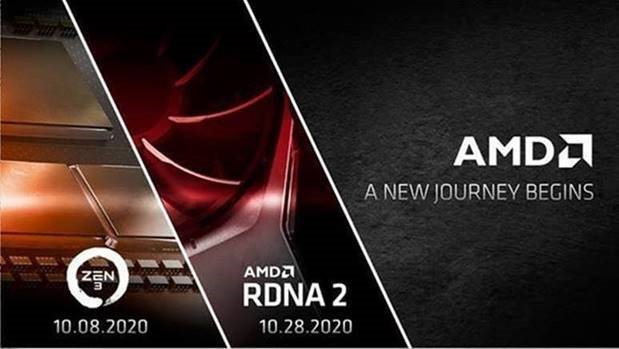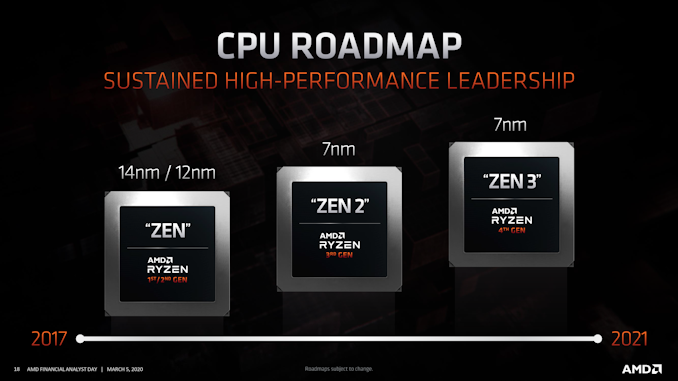AMD Announces Ryzen "Zen 3" and Radeon "RDNA2" Presentations for October: A New Journey Begins
by Ryan Smith on September 9, 2020 5:30 PM EST
AMD today has announced that they will be making a pair of consumer product presentations in October. The chipmaker, who has been fairly quiet since the spring, will be holding events for both their consumer Ryzen CPU and Radeon GPU product segments. Dubbing the events “A New Journey Begins”, the company will be announcing the first products based on their eagerly anticipated Zen 3 CPU architecture and RDNA 2 GPU architecture.
Leading the charge will be AMD’s CPU division. On October 8th at noon Eastern, the company will be presenting their Zen 3-based Ryzen desktop processors. AMD’s CEO, Dr. Lisa Su, will be among the presenters.
Following that up just under 3 weeks later will be AMD’s Radeon presentation, which again is at noon Eastern. There the company will be showing off its first products based on the company’s forthcoming RDNA 2 GPU architecture. Meanwhile, tipping their hand a bit early on naming, AMD has confirmed that this will be called the Radeon RX 6000 series.
Next Generation Ryzen Desktop Processors – 10/8, 12 p.m. ET
We are incredibly excited to invite you to learn more about the next wave of Ryzen desktop processors with “Zen 3” architecture, taking our PC gaming and content creation leadership to new heights. Dr. Lisa Su and other AMD senior executives will kick-off this new journey for “Zen 3” and AMD Ryzen at 12 p.m. ET, October 8th.
Next Generation Radeon Graphics – 10/28, 12 p.m. ET
Preparing to delight gamers globally with the next horizon of Radeon Graphics, we invite you to learn more about our RDNA 2 architecture, Radeon RX 6000 series graphics cards, and our deep collaboration with game developers and ecosystem partners who will help us bring the best of Radeon to gamers. Tune in for the reveal of the future of Radeon PC gaming at 12 p.m. ET, October 28th.
AMD hasn’t disclosed any other details about these events at this time, but over the last several months the manufacturer has shared bits and pieces of information relating to its upcoming chip architectures. Based on AMD’s roadmaps, Ryzen Zen 3 processors will be built on an improved version of TSMC’s 7nm process, most likely TSMC’s N7P process given AMD’s comments clarifying that they aren’t committing to EUV for 7nm. Otherwise, for the moment AMD is remaining tight-lipped on the Zen 3 architecture itself, though given that AMD isn’t going to get the benefits of a full node shrink, we’re expecting Zen 3 to deliver some interesting and meaningful architectural improvements over Zen 2.
Meanwhile on the graphics front, AMD and partners have previously confirmed that RDNA 2 will be a DirectX 12 Ultimate (feature level 12_2) compliant GPU architecture, meaning that AMD will be making significant changes to the graphics side of their GPU designs. The Navi 2x family of GPUs will gain support for ray tracing, variable rate shading, and other features that will put AMD’s new GPUs at parity with the competition, both for consoles and PCs. Meanwhile from a performance standpoint, AMD is aiming for a hefty 50% jump in performance-per-watt, which could potentially eliminate the efficiency gap with NVIDIA. As well, the company has previously promised a high-end "top-of-stack" GPU for 4K gaming, so we're expecting some ambitious performance goals from AMD.
Be sure to check in on October 8th and October 28th for more details on AMD’s next generation of consumer parts!
It’s going to be an exciting fall for gamers... time to start a new journey with @AMDRyzen Zen3 and @Radeon RDNA2 pic.twitter.com/O9SXvLo4y0
— Lisa Su (@LisaSu) September 9, 2020
Source: AMD












143 Comments
View All Comments
andrewaggb - Saturday, September 12, 2020 - link
He's not wrong though. I don't think 10% cheaper will win many people over. I think if they want market share they'll need to be 10% cheaper and/or 10% faster and have 16gb of ram instead of 8 or 10. But I don't see how they can be cheaper or faster and have more ram and still have respectable margins.Santoval - Sunday, September 13, 2020 - link
The top-end Big Navi will almost certainly have 16 GB of RAM, according to reasonably trustworthy leaks. Only the top-end though. In performance it will probably be targeted against the 3070; *if* it can even compete with it, that is. The 3080 is a beast and to make matters worse (for AMD, not for us) it is priced reasonably for a change.If the top-end Big Navi has roughly (i.e. within +/- 5%) the same performance as the 3070 and is priced 10 - 15% higher I believe the double memory space will be well worth it and thus would be a better buy. It would be $50 to $75 more expensive but you would get 16 GB of RAM instead of 8 GB, which would be unheard of for a consumer card at that price. If it is 20% more expensive or more I think I would choose the 3070.
Santoval - Sunday, September 13, 2020 - link
p.s. I doubt the top-end Big Navi will cost less than $599 though. Even at that price, if it's really going to have 16 GB of RAM, AMD's margin should be very narrow. If AMD cannot compete in performance I expect their marketing team to spin their fatter memory in a variety of ways..Spunjji - Tuesday, September 15, 2020 - link
@andrewaggb - You wouldn't be won over by 10% cheaper for roughly the same performance? That's fair enough, but I absolutely would be. Same goes for 10% cheaper with 10% better performance, but I have no idea why they'd charge less for a superior card. Demanding that that they be faster, cheaper and more RAM before considering a purchase would strike me as an expression of brand loyalty more than anything else. Don't get me wrong - I acknowledge that's a big factor in the market at large - I just find it weird hearing it from "enthusiasts".As for how they'd do that anyway - they have two potential assets here:
1) TSMC's 7nm process. It's more mature and has a higher density, so in theory, with the right chip they could get better yields than Nvidia and a higher proportion of chips that perform well, reducing the costs of their highest-binned GPU.
2) We already know Nvidia's driving their designs hard - early testing indicates that they appear to have burned much of their gains in performance per watt on getting *even more performance* out of them. AMD could (potentially) produce cards between the 3060 and 3080 performance levels based on smaller dies that require less power and have lower cooling requirements, much like they did back with the HD 4000 series. Adding up savings on the GPU itself, the board design and the cooler, that could come out quite nicely in their favour - *if* that's what they decided to do.
Manch - Tuesday, September 15, 2020 - link
They don't need margins at this point, they need mindshare, and market share. Most people aren't brand agnostic and buy what's popular.The big question is how will the 6 series perform? It needs to match perf & undercut Nvidia and sacrifice margins to do so if need be. ZEN can easily cover the loss. Otherwise they wont gain market share.
Santoval - Sunday, September 13, 2020 - link
"That 3070 in particular looks to be solid 4k gaming card."Yes it does, but oddly the 3080 has even better bang (FP32 TFLOPs) for the buck, which I don't think has ever happened before. I concur that AMD's next-gen graphics cards will apparently* compete with the 3070 at best. The top Big Navi card will of course has twice the memory but it is unclear if it will be faster.
Some early leaks suggested that the top-end Big Navi will handily beat the 2080 Ti in performance, but according to the performance values of these leaks (which, I know, should be handled with a bucket of salt) that places it around the level of the 3070 in performance, at best. So, once again, the 3080 and later the 3080 Ti will be way beyond the reach of AMD, in a continuation of the status quo of the last several generations. So the only reason someone might pick AMD would be the much larger memory space at a far lower price than the 3090.
*Unless of course AMD surprises us all and pulls out a dual GPU chiplet based beast of a graphics card, which I strongly doubt will happen. Most likely both AMD and Nvidia will move to a chiplet scheme from the next generation (AMD from the next-next, i.e RDNA 3). Nvidia's Hopper will almost certainly be chiplet based; it makes little sense to fab huge reticle stretching dies with poorer yields, and besides Intel's first generation of graphics cards will be chiplet based anyway. If Nvidia and AMD do not move to chiplet based GPUs Intel might steal the performance crown from them simply by adding more chiplets.
Spunjji - Tuesday, September 15, 2020 - link
Where's the information about the 3070-level performance coming from? The only things I've seen are from quite a long time ago - further back than would be useful for predictions now.Based only on the known performance of Navi 10, the most likely configuration of a Big Navi (80 CUs), and the claimed improvements in performance per watt for RDNA 2, we're most likely to be looking at something that approaches 3080 performance levels in a similar power envelope and potentially a slightly smaller die area. Bear in mind that AMD don't have to match Nvidia's claimed FP32 performance to match the card's actual performance in games (there's clearly something unusual going on in that regard, which is why Nvidia are suddenly so keen on that metric).
AMD are extremely unlike to compete with the 3090 - but they don't really have to.
The really big question is how they do on RT performance - we could easily end up with a similar situation to the early days of DX10 tessellation here, where a different (and weaker) hardware implementation combined with games being designed for Nvidia's setup results in impaired performance on AMD hardware.
sonny73n - Friday, September 11, 2020 - link
“Exciting times.”Get a life!
Drumsticks - Wednesday, September 9, 2020 - link
Looking forward to seeing what Zen 3 and RDNA2 can do. I'm quite worried for AMD that choosing not to have any comparisons out before the Ampere launch is going to cost them a measurable chunk of sales, though. People on the fence about buying Ampere might well decide to just do it and take Nvidia's proven performance to get a GPU 2 months sooner than AMD.nandnandnand - Wednesday, September 9, 2020 - link
Even RTX 3070 could be out by then. Seems very late.